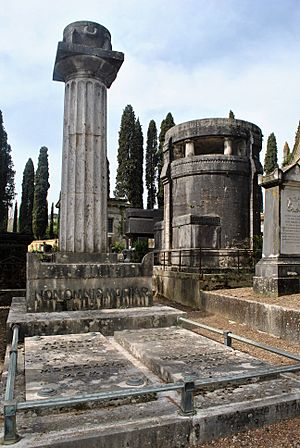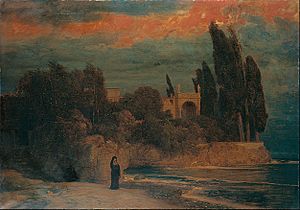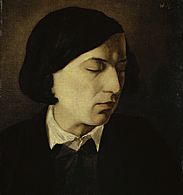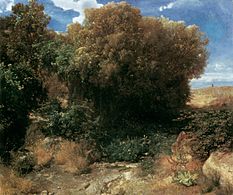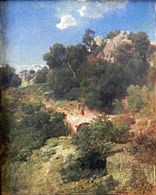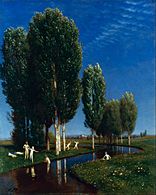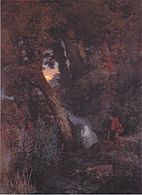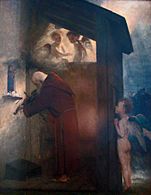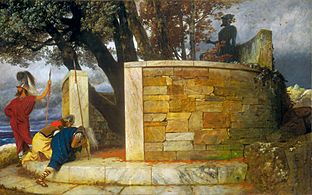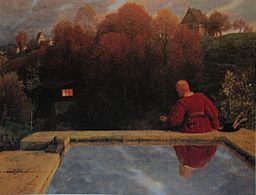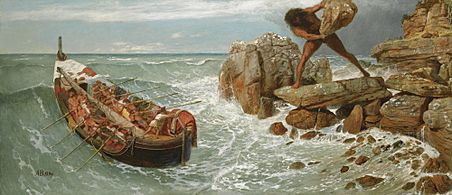Arnold Böcklin facts for kids
Quick facts for kids
Arnold Böcklin
|
|
|---|---|
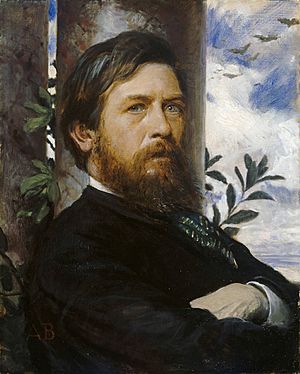
Self-portrait
Oil on canvas (1872) |
|
| Born |
Arnold Böcklin
16 October 1827 |
| Died | 16 January 1901 (aged 73) |
| Nationality | Swiss |
| Known for | Painting |
|
Notable work
|
Isle of the Dead |
| Movement | Symbolism |
Arnold Böcklin (16 October 1827 – 16 January 1901) was a Swiss Symbolist painter. He is famous for his unique style that often mixed mythology, fantasy, and nature. His paintings often explored themes of life, death, and dreams.
Contents
About Arnold Böcklin
Early Life and Studies
Arnold Böcklin was born in Basel, Switzerland. His father, Christian Frederick Böcklin, was involved in the silk trade. Arnold showed early talent for art.
He began his art studies at the Kunstakademie Düsseldorf in Germany. There, he learned from Johann Wilhelm Schirmer, a well-known landscape painter. Schirmer saw great promise in Böcklin. He encouraged Arnold to travel and study the works of famous artists.
Böcklin traveled to Antwerp and Brussels in Belgium. He copied paintings by old Flemish and Dutch masters. Later, he went to Paris, France, and studied at the Musée du Louvre. He painted several landscapes during this time.
Life in Rome
In 1850, Böcklin moved to Rome, Italy. The ancient city greatly inspired him. The sights of Rome, with its rich history and mythology, started to influence his art. He began to include figures from myths and legends in his paintings.
In 1853, he married Angela Rosa Lorenza Pascucci in Rome. They had many children together. Böcklin faced some health challenges during his life, including a serious illness in 1859.
Artistic Career and Travels
After his time in Rome, Böcklin returned to Munich, Germany, for four years. Here, he showed his painting The Great Park, which featured ancient mythology. Other important works from this period include Nymph and Satyr and Heroic Landscape (Diana Hunting).
These paintings were quite popular and helped him get a job. He became a professor at the Bauhaus-University Weimar art academy. He taught there for two years. During this time, he painted Venus and Love and a Portrait of Lenbach.
Böcklin returned to Rome from 1862 to 1866. He painted works like Portrait of Mme Böcklin and An Anchorite in the Wilderness. He also created A Roman Tavern and Villa on the Seashore.
He moved back to Basel in 1866 to work on frescoes (wall paintings) in a gallery. He also painted portraits and other works like The Magdalene with Christ. In 1872, he painted his famous Portrait of Myself, with Death playing a violin. This was after he moved back to Munich.
From 1876 to 1885, Böcklin lived in Florence, Italy. He painted many well-known pieces there, such as Pietà, Ulysses and Calypso, and Prometheus.
Later, he lived in Zürich, Switzerland, and then settled near Florence again. During these years, he painted Naiads at Play, A Sea Idyll, and War.
Arnold Böcklin passed away on January 16, 1901, in Fiesole, Italy. He is buried in the Cimitero degli Allori in Florence.
Symbolism in his Art
Böcklin's art is known for its Symbolist style. This means his paintings often used images from myths and legends to represent ideas or feelings. He was influenced by the Romanticism art movement.
Many of his paintings show imaginative scenes from the classical world. They feature mythological characters in settings with ancient buildings. He often explored themes of death and life in a strange, dreamlike way.
His most famous work is Isle of the Dead. He painted five different versions of it between 1880 and 1886. The painting was partly inspired by the English Cemetery, Florence, where his baby daughter was buried. A woman who wanted a painting with a dreamlike feeling first asked him to create it.
His Legacy
Arnold Böcklin had a big influence on many artists. Giorgio de Chirico, a famous painter, said that Böcklin's works were "a shock." Böcklin also inspired Surrealist painters like Max Ernst and Salvador Dalí. Even Marcel Duchamp, another important artist, mentioned Böcklin as an influence.
The artist H. R. Giger created a picture called Homage to Boecklin, which was based on Böcklin's Isle of the Dead.
You can see many of Böcklin's paintings in museums today. The Kunstmuseum Basel and the Kunsthaus Zürich in Switzerland have collections of his work.
In Music
Böcklin's paintings, especially Isle of the Dead, inspired many composers.
- Gustav Mahler's song Des Antonius von Padua Fischpredigt was inspired by Böcklin's painting St. Anthony Preaching to the Fish.
- Sergei Rachmaninoff composed a famous symphonic poem called Isle of the Dead after Böcklin's painting. Rachmaninoff was also inspired by Böcklin's The Homecoming for one of his piano preludes.
- Max Reger composed a set of Four Tone Poems after Böcklin, with movements named after his paintings.
Other Influences
- A special type of Art Nouveau writing font, designed in 1904, was named "Arnold Böcklin" in his honor.
- The writer Roger Zelazny titled one of his novels Isle of the Dead after Böcklin's paintings. The cover art for the book also looked similar to Böcklin's style.
Works
Images for kids
See also
 In Spanish: Arnold Böcklin para niños
In Spanish: Arnold Böcklin para niños


